Over 30 years of anarchist writing from Ireland listed under hundreds of topics
History
1916 - Connolly, blood sacrifice and defeating British imperialism
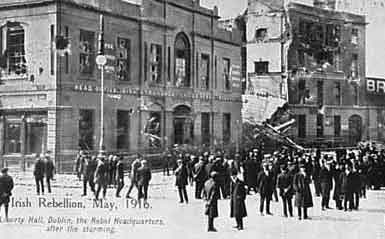 At 11.30 in the morning of April 24 1916 Bugler William Oman, a member of a syndicalist workers militia the Irish Citizen Army (ICA), sounded the 'fall-in' outside his union headquarters. This was the start of an insurrection in Dublin which was to see around 1,500 armed men and women seize key buildings throughout the city, and to hold these positions against thousands of British Army soldiers for almost a week. In the course of putting down the insurrection, 1351 people were killed or severely wounded and 179 buildings in the city centre were destroyed.(1)
At 11.30 in the morning of April 24 1916 Bugler William Oman, a member of a syndicalist workers militia the Irish Citizen Army (ICA), sounded the 'fall-in' outside his union headquarters. This was the start of an insurrection in Dublin which was to see around 1,500 armed men and women seize key buildings throughout the city, and to hold these positions against thousands of British Army soldiers for almost a week. In the course of putting down the insurrection, 1351 people were killed or severely wounded and 179 buildings in the city centre were destroyed.(1)
Image: Liberty hall after the rising
1916, left republicanism, anarchism and class struggle
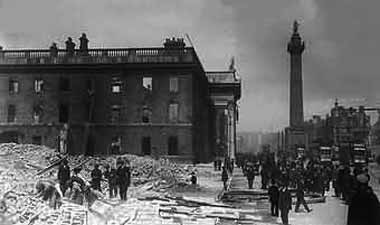 This article is an anarchist analysis of the 1916 insurrection and the war of independence in the context of the struggle for socialism in Ireland and internationally. It concentrates on the 'unknown' but intense class struggle that ran alongside the war of independence and the role republicanism played in the suppression of that struggle. It asks 'what is freedom' and shows how anarchism originated amongst earlier European left republicans as an answer to the limitations of republicanism.
This article is an anarchist analysis of the 1916 insurrection and the war of independence in the context of the struggle for socialism in Ireland and internationally. It concentrates on the 'unknown' but intense class struggle that ran alongside the war of independence and the role republicanism played in the suppression of that struggle. It asks 'what is freedom' and shows how anarchism originated amongst earlier European left republicans as an answer to the limitations of republicanism.
Image: O'Connell street after the insurrection
An anarchist look at the ideas of James Connolly - the single most important figure in the history of the Irish left
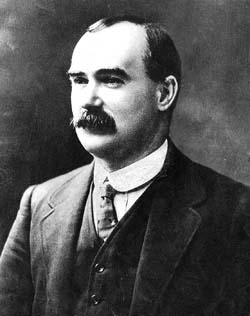 James Connolly is probably the single most important figure in the history of the Irish left. He was an organiser in the IWW in the USA but in Ireland is best known for his role in building the syndicalist phase of Irish union movement and for involving the armed defence body of that union, the Irish Citizens' Army in the 1916 nationalist insurrection. This left a legacy claimed at one time or another not only by all the Irish left parties but also by the nationalists of Fianna Fail and Sinn Fein. In this article I will attempt to look at the long neglected anarchistic aspects of Connolly's thought and ask the question was Connolly a libertarian?
James Connolly is probably the single most important figure in the history of the Irish left. He was an organiser in the IWW in the USA but in Ireland is best known for his role in building the syndicalist phase of Irish union movement and for involving the armed defence body of that union, the Irish Citizens' Army in the 1916 nationalist insurrection. This left a legacy claimed at one time or another not only by all the Irish left parties but also by the nationalists of Fianna Fail and Sinn Fein. In this article I will attempt to look at the long neglected anarchistic aspects of Connolly's thought and ask the question was Connolly a libertarian?
Industrial Collectivisation during the Spanish Revolution
 Within hours of the start of the Spanish revolution workers had seized control of 3000 enterprises. This included all public transportation services, shipping, electric and power companies, gas and water works, engineering and automobile assembly plants, mines, cement works, textile mills and paper factories, electrical and chemical concerns, glass bottle factories and perfumeries, food processing plants and breweries. (Image: Public transport was one of the first industries to be collectivised)
Within hours of the start of the Spanish revolution workers had seized control of 3000 enterprises. This included all public transportation services, shipping, electric and power companies, gas and water works, engineering and automobile assembly plants, mines, cement works, textile mills and paper factories, electrical and chemical concerns, glass bottle factories and perfumeries, food processing plants and breweries. (Image: Public transport was one of the first industries to be collectivised)
Bakunin's ideas on revolutionary organisation
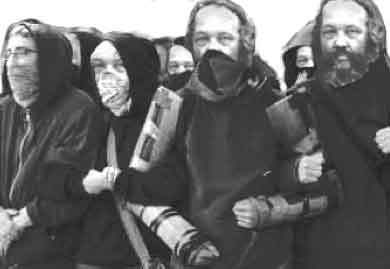
The Russian revolutionary Micheal Bakunin is often presented as the 'founding father' of anarchism. He was a larger than life figure whose disputes with Marx in the 1st international form an essential role in the clarification of the role of the vanguard and of the state in the revolutionary process. Yet his concrete ideas on anarchist organisation are not so well knowm. Andrew N. Flood takes a closer look at them.
The 1798 Rebellion
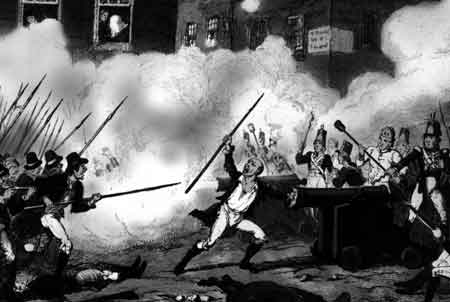 In 1798 Ireland was shook by a mass rebellion for democratic rights and against British rule. 200 years later 1798 continues to loom over Irish politics. The bi-centenary, co-inciding with the 'Peace process', has attracted considerable discussion, with the formation of local history groups, the holding of conferences and a high level of interest in the TV documentaries and books published around the event.
In 1798 Ireland was shook by a mass rebellion for democratic rights and against British rule. 200 years later 1798 continues to loom over Irish politics. The bi-centenary, co-inciding with the 'Peace process', has attracted considerable discussion, with the formation of local history groups, the holding of conferences and a high level of interest in the TV documentaries and books published around the event.
The Anarchist Collectives in the Countryside during the Spanish Civil War
Many people, upon hearing about Anarchism, consider a society based on anarchist principles as unrealistic, idealistic and naive - the vision of dreamers. Given the homogenous view of the world represented in the media, it is often difficult for people to imagine a society where such universally accepted institutions as the state, the judiciary system, the police, armies, and nations no longer exist.
Freedom and Revolution: The Bolshevik Experience.
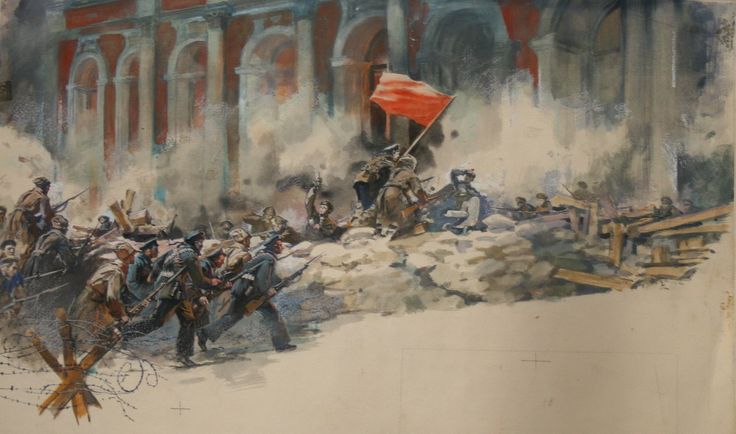 Does the end justify the means? Many on the left believe so. Aileen O'Carroll argues that the means used play a part in creating the end that is achieved. The best example of this is the Russian Revolution of 1917.
Does the end justify the means? Many on the left believe so. Aileen O'Carroll argues that the means used play a part in creating the end that is achieved. The best example of this is the Russian Revolution of 1917.
In 1922 Emma Goldman complained Soviet Russia, had become the modern socialist Lourdes, to which the blind and the lame, the deaf and the dumb were flocking for miraculous cures(1). The Russian Revolution was the first occasion where decades of revolutionary ideas could be applied to real life. What was theory was now practice. The struggle between the two concepts of revolution - the statist-centralist and the libertarian federalist - moved from the realm of the abstract to the concrete.
The question thrown up by the October revolution is fundamental. Once capitalism has been defeated, how is communism to be achieved? While there are certainly faults to be found with aspects of the anarchist movement, at least it cannot be criticised for getting the basics wrong. Anarchists have consistently argued that freedom and democracy are not optional extras. Rather they form part of the conditions necessary for the growth of communism.
An introduction to the Russian Revolution from an anarchist perspective
The Russian revolution of 1917 has been a subject of key importance to anarchists for 70 years now, for two reasons. The first reason is that for the first time in history a working class revolution succeeded in ousting the old ruling classes. The second reason is that after the old ruling class was ousted a new class came to power. Those of us who want to make a revolution to-day must understand where the successes and failures of the past came from.
The Dublin Lock-out of 1913 and the ITGWU
In 1913 militant trade unionism had a tremendous task ahead of it. The poverty of manual workers was appalling. The death rate in Dublin, 27.6 per 1OOO, was as high as Calcutta's, The slums were the worst of any city in either Ireland or Britain. 20,108 families were recorded as living in a single room. An Irish Times editorial commenting on a report about Dublin housing wrote that "28,000 of our fellow citizens live in dwellings which even the Corporation admits to be unfit for human habitation. Nearly a third of our population so live that from dawn to dark and from dark to dawn it is without cleanliness, privacy or self respect. Sanitary conditions ruled out ordinary standards of savage morality''

